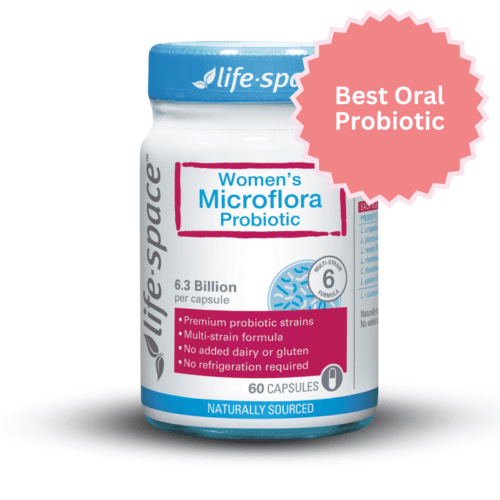Fibre is a critical component of a healthy diet, with a multitude of benefits, including improving digestion, weight management, and chronic disease prevention, while playing a critical role in a healthy gut microbiome.
Additionally, fibre can also help regulate hormones by removing hormones via the digestive tract1. Additionally, those who have inadequate fibre intake are at greater risk of pelvic organ prolapse2.
Big jobs for a tiny fibre!
Fibre is a type of carbohydrate found in plant-based foods that the human digestive tract cannot fully digest. Other carbohydrates are broken down into simple sugars, whereas fibre passes through the digestive system relatively intact, offering a range of health benefits.
Recommended daily fibre intake
Daily fibre requirements depend on your body size – smaller people need less than larger people. An average adult woman, for example, needs around 26 grams of fibre per day, while an average adult man needs around 38 grams3.
| Food | Serving | Soluble Fiber (g) | Insoluble Fiber (g) | Total Fiber (g) |
|---|---|---|---|---|
| Adzuki Beans | 1 cup cooked | 17 | ||
| Lentils, Red Lentils | 1 cup cooked | 15.6 | ||
| Mung Beans | 1 cup cooked | 15.4 | ||
| Cannellini Beans | 1 cup cooked | 12.4 | ||
| Great Northern Beans | 1 cup cooked | 12.4 | ||
| Wheat bran | ½ cup | 11.3 | 1 | 12.3 |
| Beans, White Beans | 1 cup cooked | 11 | ||
| Black-eyed Peas | 1 cup cooked | 11 | ||
| Baked Beans | 1 cup | 10.4 | ||
| Acorn Squash | 1 cup cooked | 9 | ||
| Fava Beans | 1 cup cooked | 9 | ||
| Edamame | 1 cup cooked | 8 | ||
| Psyllium seeds | 2 tbsp. | 7.1 | 0.9 | 8 |
| Spelt | 1 cup cooked | 7.6 | ||
| Pinto beans, cooked | ½ cup | 5.5 | 1.9 | 7.4 |
| Kale, cooked | 1 cup | 2.1 | 5.1 | 7.2 |
| Teff | 1 cup cooked | 7.1 | ||
| Black beans, cooked | ½ cup | 3.8 | 3.1 | 6.9 |
| Avocado | 1/2 medium | 6.7 | ||
| Butternut Squash | 1 cup cooked | 6.6 | ||
| Lentils, cooked | ½ cup | 2.8 | 3.8 | 6.6 |
| Artichoke, cooked | 1 medium | 4.7 | 1.8 | 6.5 |
| Sorghum | 1 cup cooked | 6.3 | ||
| Wholegrain pasta | 1 cup | 4.1 | 2.2 | 6.3 |
| Whole Wheat Spaghetti | 1 cup cooked | 6 | ||
| Kidney beans, cooked | ½ cup | 2.9 | 2.9 | 5.8 |
| Apple with skin | 1 medium | 4.2 | 1.5 | 5.7 |
| Chia Seeds | 1 tbsp | 5.5 | ||
| Collard Greens | 1 cup cooked | 5.3 | ||
| Figs, dried | 3 medium | 3 | 2.3 | 5.3 |
| Amaranth | 1 cup cooked | 5.2 | ||
| Bran Flakes Cereal | 3/4 cup | 5 | ||
| Farro | 1 cup cooked | 5 | ||
| Turnip Greens | 1 cup cooked | 5 | ||
| Soybeans (edamame) | ½ cup | 2.7 | 2.2 | 4.9 |
| Sweet potato, peeled | 1 medium | 2.7 | 2.2 | 4.9 |
| Flaxseeds | 2 tbsp. | 2.7 | 2.1 | 4.8 |
| Potato with skin | 1 medium | 2.4 | 2.4 | 4.8 |
| Buckwheat | 1 cup cooked | 4.5 | ||
| Green peas, cooked | ½ cup | 3.2 | 1.2 | 4.4 |
| Strawberries | 1 cup | 1.8 | 2.6 | 4.4 |
| Lima beans, cooked | ½ cup | 2.1 | 2.2 | 4.3 |
| Spinach | 1 cup cooked | 4.3 | ||
| Almonds, raw | 1 ounce | 0.7 | 3.5 | 4.2 |
| Barley, cooked | ½ cup | 3.3 | 0.9 | 4.2 |
| Quinoa, cooked | ½ cup | 1.7 | 2.5 | 4.2 |
| Garbanzo beans, cooked | ½ cup | 1.2 | 2.8 | 4 |
| Oat bran, cooked | ¾ cup | 2.2 | 1.8 | 4 |
| Oatmeal, cooked | 1 cup | 2.4 | 1.6 | 4 |
| Pear | 1 medium | 0.8 | 3.2 | 4 |
| Wheat germ | 3 tbsp. | 3.2 | 0.7 | 3.9 |
| Beets | 1 cup cooked | 3.8 | ||
| Blackberries | ½ cup | 3.1 | 0.7 | 3.8 |
| Swiss Chard | 1 cup cooked | 3.7 | ||
| Blueberries | 1 cup | 3.6 | ||
| Brussel Sprouts, cooked | 1 cup | 1.7 | 1.9 | 3.6 |
| Popcorn, air-popped | 3 cups | 3.2 | 0.4 | 3.6 |
| Apricots, dried | 4 medium | 1.8 | 1.7 | 3.5 |
| Split peas, cooked | ½ cup | 1.1 | 2.4 | 3.5 |
| Cauliflower | 1 cup cooked | 3.4 | ||
| Orange | 1 medium | 2.1 | 1.3 | 3.4 |
| Sesame seeds | ¼ cup | 0.7 | 2.6 | 3.3 |
| Kiwi | 1 large | 2.4 | 0.8 | 3.2 |
| Raspberries | ½ cup | 0.9 | 2.3 | 3.2 |
| Grapefruit | ½ of large | 2.4 | 0.7 | 3.1 |
| Oranges | 1 medium | 3.1 | ||
| Prunes | 4 medium | 1.3 | 1.8 | 3.1 |
| Walnuts | 1 ounce | 0.6 | 2.5 | 3.1 |
| Pistachios | 1 oz | 3 | ||
| Pumpkin | 1 cup cooked | 3 | ||
| Rice, Wild | 1 cup cooked | 3 | ||
| Sunflower seeds | ¼ cup | 1.1 | 1.9 | 3 |
| Wholegrain bread | 1 slice | 2.8 | 0.1 | 2.9 |
| Asparagus, cooked | ½ cup | 1.7 | 1.1 | 2.8 |
| Banana | 1 medium | 2.1 | 0.7 | 2.8 |
| Broccoli, raw | ½ cup | 1.3 | 1.4 | 2.7 |
| Coconut | 1 oz | 2.7 | ||
| Hazelnuts | 1 oz | 2.7 | ||
| Pecans | 1 oz | 2.7 | ||
| Rye bread | 1 slice | 1.9 | 0.8 | 2.7 |
| Carrot, raw | 1 medium | 1.1 | 1.5 | 2.6 |
| Mango | 1 cup sliced | 2.6 | ||
| Zucchini, cooked | ½ cup | 1.4 | 1.2 | 2.6 |
| Papaya | 1 cup cubes | 2.5 | ||
| Squash, summer, cooked | ½ cup | 1.3 | 1.2 | 2.5 |
| Whole Grain Cornmeal | 1 cup cooked | 2.4 | ||
| Millet | 1 cup cooked | 2.3 | ||
| Peanuts, dry roasted | 1 ounce | 1.1 | 1.2 | 2.3 |
| Pineapple | 1 cup chunks | 2.3 | ||
| Plums | 2 medium | 1.2 | 1 | 2.2 |
| Brazil Nuts | 1 oz | 2.1 | ||
| Green beans, cooked | ½ cup | 0.8 | 1.2 | 2 |
| Whole wheat bread | 1 slice | 1.6 | 0.3 | 1.9 |
| Poppy Seeds | 1 tbsp | 1.8 | ||
| Pumpernickel bread | 1 slice | 1.5 | 1.2 | 1.7 |
| Pumpkin Seeds | 1 oz | 1.7 | ||
| Tahini | 1 tbsp | 1.6 | ||
| Brown rice, cooked | ½ cup | 1.3 | 0.1 | 1.4 |
| Cantaloupe | 1 cup cubes | 1.4 | ||
| Chestnuts | 1 oz | 1.4 | ||
| Tomato with skin | 1 medium | 0.3 | 1 | 1.3 |
| Cashews | 1 oz | 0.9 | ||
| Hemp Seeds | 1 tbsp | 0.9 | ||
| Watermelon | 1 cup cubes | 0.6 |
Tips on increasing fibre intake
- It’s important to stay hydrated when increasing fibre intake, to keep stools soft and easy to pass.
- A fibre supplement can be helpful to some people when adequate intake is difficult.
- When increasing fibre intake, don’t rush to do it all at once – work up to optimal intake gradually, so your microbiome and digestive system can adjust.
- Add oatmeal, chia seeds, raspberries or blueberries to breakfast cereals or smoothies.
- Add a handful of nuts and seeds to any meal, savoury or sweet, as you like.
- Use whole grains and wholegrain flour.
- Add rinsed canned beans to any dish that suits, such as soups or casseroles, or a handful into salads.
- Learn how to cook grains (and seeds) well by getting tips online for perfect outcomes every time, e.g. brown rice, wild rice, quinoa.
Use this table to work out how much of each type of food you need to meet your daily fibre needs.
There are two main types of dietary fibre, soluble and insoluble, with each playing an important role.
Soluble fibre
Soluble fibre dissolves in water – hence ‘soluble’ – and forms a gel-like substance. Soluble fibre is found in abundance in foods like oats, nuts, seeds, beans, lentils, and some fruits and vegetables. The gel formed by soluble fibre slows down digestion, which has several beneficial effects.
- Soluble fibre helps regulate blood sugar by slowing the uptake of sugars from the digestive tract, due to the slowing down of the overall digestive process.
- Soluble fibre binds to certain types of cholesterol in the digestive tract, where it is then excreted.
- Importantly, soluble fibre acts as a prebiotic – food – that provides an energy source for healthy gut bacteria.
Insoluble fibre
Insoluble fibre can’t dissolve in water – it is insoluble. Instead, it adds bulk to stool and helps food pass more quickly through the digestive tract. Good sources of insoluble fibre include whole grains, wheat bran, and fruit and vegetable skins.
Insoluble fibre acts like a ‘broom’ to clean out the intestines, preventing constipation and supporting regular, healthy bowel movements. Insoluble fibre is like hay and mud, used to bulk up stools and help them out of the body, taking all the junk with it and keeping the intestinal walls clear.
Both soluble and insoluble fibre are important for overall health and the prevention of some chronic diseases.
References
- 1.Gaskins AJ, Mumford SL, Zhang C, et al. Effect of daily fiber intake on reproductive function: the BioCycle Study. The American Journal of Clinical Nutrition. Published online October 2009:1061-1069. doi:10.3945/ajcn.2009.27990
- 2.Arya LA, Novi JM, Shaunik A, Morgan MA, Bradley CS. Pelvic organ prolapse, constipation, and dietary fiber intake in women: A case-control study. American Journal of Obstetrics and Gynecology. Published online May 2005:1687-1691. doi:10.1016/j.ajog.2004.11.032
- 3.Dahl WJ, Stewart ML. Position of the Academy of Nutrition and Dietetics: Health Implications of Dietary Fiber. Journal of the Academy of Nutrition and Dietetics. Published online November 2015:1861-1870. doi:10.1016/j.jand.2015.09.003
The most comprehensive vaginal microbiome test you can take at home, brought to you by world-leading vaginal microbiome scientists at Juno Bio.
Unique, comprehensive BV, AV and 'mystery bad vag' treatment guide, one-of-a-kind system, with effective, innovative treatments.
Promote and support a protective vaginal microbiome with tailored probiotic species.






